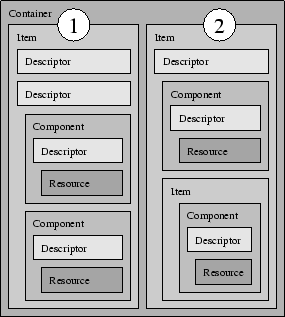Multichannel Publication using MPEG-21 DIDL and extensions
Steven Van Assche
VRT
Auguste Reyerslaan 52
Brussels, Belgium
steven.vanassche@vrt.be
Filip Hendrickx
Imec
Kapeldreef 75
Leuven, Belgium
filip.hendrickx@imec.be
Lode Nachtergaele
Imec
Kapeldreef 75
Leuven, Belgium
lode.nachtergaele@imec.be
ABSTRACT
This poster discusses the multichannel publication of multimedia presentations
using MPEG-21 DIDL and extensions. Different descriptions belonging to one
MPEG-21 content item are combined and processed into a publication targeted at
a specific channel and platform.
Keywords
Multimedia, multichannel publication, device independent publishing, MPEG-21
DIDL
1. INTRODUCTION
Nowadays, content creators are looking for ways to publish their content
cost-efficiently in a multichannel environment, which means publishing content
via multiple channels to various consumption platforms. This is only possible
if the content (predominantly high quality audio-visual media in this example)
is adapted to the specific target platforms, both from a technical (client
capabilities, such as available downstream bandwidth and supported media
formats) and a rhetorical viewpoint (the way the information is conveyed to the
user). It is clear that content reuse is of prime importance when publishing in
a multichannel environment. Ideally, all content is produced only once and
straightforwardly converted to the appropriate formats for the target channels.
This is called the ``create once, publish anywhere'' content production
paradigm.
This poster demonstrates the use of MPEG-21 DIDL in multichannel publication.
The generic hierarchical structure stimulates content reuse and extensibility.
This is shown using an example.
2. EXTENDING MPEG-21 DIDL
The basic concept in the MPEG-21 DIDL model is the digital item, which is a
structured digital object with its meta-data. Such an item is a grouping of
sub-items and components that are bound to relevant descriptors. The
descriptors contain information (meta-data) about the item. A component is the
binding of a resource to a set of descriptors. The descriptors hold the
information related to the specific resource instance. Examples of textual
descriptors are descriptive, control, revision tracking or identifying
information. A resource is an individually identifiable asset such as a video
or audio clip, an image, or a textual asset. In our model we would call a
resource a piece of essence.
Figure 1 shows an example MPEG-21 DIDL document.
The document has a container with two items. There is one item holding two
descriptors and two components. The components each have a resource and an
asscociated descriptor and represent, for example, different compression
quality versions of the same picture. The second item shows an item containing
a sub-item.
Figure 1: The hierarchical structure of a MPEG-21 DIDL
document. 1. Digital item with two components (for example, different quality
versions) and two descriptors. 2. Digital item with a sub-item.
 |
The MPEG-21 DIDL descriptor is a very generic concept, to which we add some
more structure by attaching a version and type attribute. The version helps
keep track of different versions or variants. It is a Uniform Resource Name
(URN); the type attribute is free text. An example of a version attribute is www:xhtml1.1:2.0,
which stands for a description variant for the web, using XHTML 1.1, and with
running version 2.0. Example descriptor types are Layout and Synchronization.
This extension is called XiMPF (eXtensible Interactive Multimedia Publication
Format).
3. EXAMPLE MULTICHANNEL PUBLICATION OF A PHOTO ALBUM
In order to demonstrate the multichannel publication capabilities, we elaborate
on an example multichannel publication. We create a presentation of a photo
album showing a series of pictures together with corresponding text.
Figures 3, 4
and 5 show the MPEG-21 item with
essence components and spatial or temporal positional descriptors.
Figure 2: SMIL (left), HTML-TIME (middle) and Java version
(right) of the photo album.
 |
Figure 3: Digital item representing an image. The item has two
image versions: a PAL-version and a thumbnail version.
<Item id="photo_1">
<Component ximpf:version="pal">
<Resource ref="photo_1_720x576.jpg"/>
</Component>
<Component ximpf:version="thumbnail">
<Resource ref="photo_1_100x80.jpg"/>
</Component>
</Item>
|
Figure 4: Synchronization descriptor of the sequential
presentation. Each image will be shown during 5s.
<Descriptor
ximpf:type="Synchronization"
ximpf:version="sequential">
<Statement type="text/xml/smil-2.0">
<smil:seq>
<ximpf:UseItem ximpf:referrer="img_1"
smil:dur="5s"/>
<ximpf:UseItem ximpf:referrer="img_2"
smil:dur="5s"/>
...
</smil:seq>
</Statement>
</Descriptor>
|
Figure 5: Layout descriptor that adds a margin.
<Descriptor
ximpf:type="Layout"
ximpf:version="withMargin">
<Statement type="text/css2">
margin: 5px;
</Statement>
</Descriptor>
|
We then derive three final form presentations from the generic XiMPF
description: a SMIL version, an HTML-TIME version and a Java version.
Screenshots of these three publications are shown in Figure 2.
The look and feel is the same in all three versions, except for the text in the
SMIL version, because text in SMIL should be styled with another markup
language.
4. CONCLUSIONS
The presented multichannel publication framework is based on MPEG-21 DIDL and
some extensions. In the example, we demonstrated that the publication
infrastructure is capable of handling multichannel publications. From the same
content, publications were constructed for very different target platforms.
5. ACKNOWLEDGEMENTS
This work is a result of a joint collaboration between Vlaamse Radio en
Televisie (VRT, public broadcaster of Flanders), IMEC and Vrije Universiteit
Brussel (VUB). This is one of the E-VRT projects funded by the Flemish
government.
6. REFERENCES
-
Cascading Style Sheets, level 2 - W3C Recommendation, may 1998.Available at
http://www.w3.org/TR/1998/REC-CSS2-19980512.
-
ISO/IEC. MPEG-21 - Part 2: Digital Item Declaration - ISO/IEC FDIS 21000-2.
-
Patrick Schmitz. Synchronized Multimedia Integration Language (SMIL) -
HTML+SMIL Language Profile. W3C, jun 2000. Available at
http://www.w3.org/TR/2000/WD-smil-boston-20000622/html-smil-profile.html.
-
Jacco van Ossenbruggen, Joost Geurts, Frank Cornelissen, Lynda Hardman, and
Lloyd Rutledge. Towards second and third generation web-based multimedia. In Tenth
International World Wide Web Conference, Hong Kong, may 2001. IW3C2.
-
W3C. Extensible HyperText Markup Language (XHTML) 1.0 - W3C Recommendation, jan
2000. Available at http://www.w3.org/TR/2000/REC-xhtml1-20000126.
-
W3C. Synchronized Multimedia Integration Language (SMIL) 2.0 - W3C
Recommendation, aug 2001. Available at
http://www.w3.org/TR/2001/REC-smil20-20010807
.

